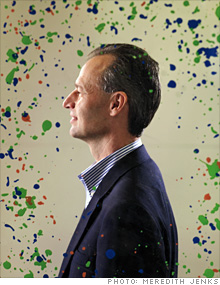A high-tech paint investment pays off
An Arizona entrepreneur brushes greatness.
 |
| Mel Sauder, CEO of MicroBlend Technologies |
(Fortune Small Business) -- With residential construction in the doldrums, paint manufacturers face a dreary summer. Yet Mel Sauder's outlook is bright. In the past two years the annual revenue for his 30-employee company, MicroBlend Technologies, has grown from $1.5 million to $3.5 million. He expects to hit $5 million this year, thanks to the increasing popularity of the company's Automated Paint Machine -- APM for short -- which sells for $100,000 and up and mixes six liquid components into any grade, finish and color, saving retailers the hassle of stocking hundreds of different cans. The APM's built-in software measures and tints paint by weight, not volume; devotees say it delivers very consistent color.
MicroBlend's future used to look less stable than its color palette. When Sauder joined the Gilbert, Ariz., firm in 2002, MicroBlend was struggling to market its custom-mixing solution to big paint manufacturers.
In an earlier job Sauder had helped Fujicolor Processing create a national network of photo minilabs. So he retooled MicroBlend to reflect the kiosk strategy he knew so well, pitching stand-alone paint machines directly to Costco (COST, Fortune 500) and Sears (SHLD, Fortune 500). That decision paved the way for expansion. In December 2008, when housing starts plunged by 13.5%, the company's growth rate soared 112% over the same month the year before.
Not everyone thinks Sauder can keep it up. Jerry Rabushka, editor of The Paint Dealer, says the APM is too big already. He means it literally: The behemoth takes up 130 square feet, more than most local shops can handle.
"Suddenly you're storing this whole big thing," he says. "Small stores have a hard time figuring out where to put all that." ![]()
-
The Cheesecake Factory created smaller portions to survive the downturn. Play
-
A breeder of award-winning marijuana seeds is following the money and heading to the U.S. More
-
Most small businesses die within five years, but Amish businesses have a survival rate north of 90%. More
-
The 10 most popular franchise brands over the past decade -- and their failure rates. More
-
These firms are the last left in America making iconic products now in their twilight. More








